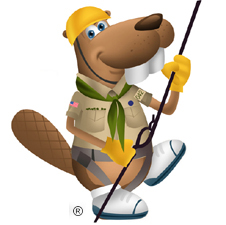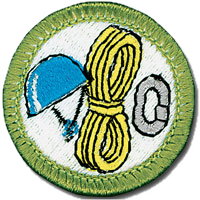Climbing


Resources
- Climbing Merit Badge Pamphlet
- Climbing Merit Badge Class Preparation Page
- Climbing Merit Badge Workbook
- Scoutmaster Bucky's Merit Badge Advancement Quick Reference
- Scoutmaster Bucky's Acknowledgement Form
Climbing Requirements
Current Scouts BSA requirements
as of December 6, 2025
as of December 6, 2025
1.
Do the following:
a.
Explain to your counselor the most likely hazards you may encounter
while participating in climbing and rappelling activities and what you
should do to anticipate, help prevent, mitigate, and respond to these
hazards.
b.
Show that you know first aid for and how to prevent injuries or
illnesses that could occur during climbing activities, including heat
and cold reactions, dehydration, stopped breathing, sprains, abrasions,
fractures, rope burns, blisters, snakebite, concussions, and insect
bites or stings.
c.
Identify the conditions that must exist before performing CPR on a
person.
2.
Learn the Leave No Trace Seven Principles and the Outdoor Code and explain
what they mean.
3.
Present yourself properly dressed for belaying, climbing, and rappelling.
Explain why you are wearing each piece of gear and discuss qualities of
easy movement, entanglement free and good weather protection and comfort.
4.
Location. Do the following:
a.
Explain how the difficulty of climbs is classified, and apply
classifications to the rock faces or walls where you will demonstrate
your climbing skills.
b.
Explain the following: top-rope climbing, lead climbing, and
bouldering.
c.
Evaluate the safety of a particular climbing area. Consider weather,
visibility, the condition of the climbing surface, and any other
environmental hazards.
d.
Determine how to summon aid to the climbing area in case of an
emergency. Discuss what medical training is needed for your group when
climbing and rappelling in remote areas.
5.
Verbal signals. Explain the importance of using verbal
signals during every climb and rappel, and while bouldering. With the help
of the counselor or another Scout, demonstrate the verbal signals used by
each of the following:
a.
Climbers
b.
Rappellers
c.
Belayers
d.
Boulderers and their spotters.
6.
Rope. Do the following:
a.
Describe the kinds of rope acceptable for use in climbing and
rappelling.
b.
Show how to examine a rope for signs of wear or damage.
c.
Discuss ways to prevent a rope from being damaged.
d.
Explain when and how a rope should be retired.
e.
Properly coil a rope.
7.
Knots. Demonstrate the ability to tie each of the
following knots. Give at least one example of how each knot is used in
belaying, climbing, or rappelling.
a.
Figure eight on a bight
b.
Figure eight follow-through
c.
Water knot
d.
Double fisherman's knot (grapevine knot)
e.
Prusik hitch applied to rope.
8.
Harness, Helmet & Gloves. Explain the purpose of each of the
following and demonstrate how to put them on correctly.
a.
Commercially made climbing harness
b.
Climbing helmet
c.
Climbing or rappeling gloves.
9.
Identify the elements of the CHECK system and describe the meaning of each
one to your counselor.
10.
Belaying. Do the following:
a.
Explain the importance of belaying climbers and rappellers and when it
is necessary.
b.
Belay three different climbers on three different routes.
c.
Serve as a backup belayer on three different climbs.
d.
Belay three different rappellers on three different routes.
e.
Serve as a backup belayer on three different rappels.
11.
Climbing. Do the following:
a.
Show the correct way to directly tie a belay rope to your harness.
b.
Climb at least three different routes on a rock face or climbing wall,
demonstrating good technique and using verbal signals with a belayer.
12.
Rappelling. Do the following:
a.
Show the correct way to directly tie a belay rope to your harness.
b.
Using a carabiner and a rappel device, attach a rappel rope to your
harness.
c.
Rappel down three different rock faces or three rappel routes on a
climbing wall. Use verbal signals to communicate with a belayer, and
demonstrate good rappelling technique.
13.
Demonstrate ways to store rope, hardware, and other gear used for climbing,
rappelling, and belaying.